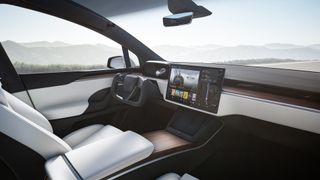Tesla EVs get a big phone key boost, but only if you’re an iPhone user
A new update to Tesla’s operating system (that’s version 2024.2.3, software fans) has introduced support for Apple’s Ultra Wideband (UWB) technology, which is in recent iPhones. This means improved functionality of the phone key, as many Tesla owners will no longer have to rely on the less accurate and less secure Bluetooth connectivity to unlock their car.
According to 9to5Macthe update was spotted by the Serial Tesla software blog No Tesla appwhich noted that UWB technology allows the vehicle and phone key “to communicate with greater accuracy to lock, unlock and open automatic doors more responsively.”
Apple already started using UWB technology in the iPhone 11 and recently introduced it in Apple Watch Ultra 2 and the latest Apple Watch Series 9, allowing the devices to communicate with each other more accurately.
In terms of benefits, the technology enables Precision Finding, which can guide an owner to a lost watch or smartphone with pinpoint accuracy. Previously, if a phone had slid along the back of a couch, Find My Phone would have only given an approximate whereabouts, but Apple Watch can now use haptic feedback to guide its owner through a series of beeps until they are just inches away.
What does this mean for Tesla’s electric vehicles? This same precision approach technology results in a much faster and more accurate response from the car, while providing added peace of mind that a Bluetooth signal will not be intercepted by would-be thieves.
According to Not a Tesla App, Tesla owners can dive into the settings of their Tesla app and upgrade the Phone Key menu to switch from Bluetooth to UWB. Requires an iPhone 11 or later and the Tesla app version 4.29.5 or later.
There’s no word yet on whether the same functionality can be replicated on Apple Watch Series 9 and Apple Watch Ultra 2, while only the latest generation of 2023 Model 3 and Model X cars, as well as the Cybertruck, will have the option to use the new functionality.
But it will likely be rolled out to more Tesla models in the near future and hopefully eventually some of the latest Android phones as well, as recent Google Pixel and Samsung Galaxy phones also have their own UWB chips.
UWB for the safety victory
Without delving too deeply into the scientific intricacies of Bluetooth Low Energy (BLE) and Ultra Wideband technologies, the chances of BLE being subject to jamming and relay (or ‘man-in-the-middle’ attacks) are high. greater due to the fact that it relies on signal strength, allowing attackers to amplify it using crude devices and ultimately trick the vehicle into thinking the owner and digital key are nearby.
UWB, on the other hand, uses different frequency pulses, which are measured to see how long it takes for the signal to travel between the signal (the phone) and the receiver (the car). The person with the phone has to be much closer for the system to work, warding off tech-savvy criminals.
In addition, it is possible to encrypt UWB technology to prevent so-called ‘preamble insertion attacks’, further increasing security levels.
Tesla’s willingness to work with Apple and its UWB technology is a boon for customers who like to use a smartphone for everything, including keyless entry. It also provides a solid framework for future updates, including adding your Tesla key to Apple Wallet, and introducing more precise location accuracy for when you lose your car in a crowded parking lot.

